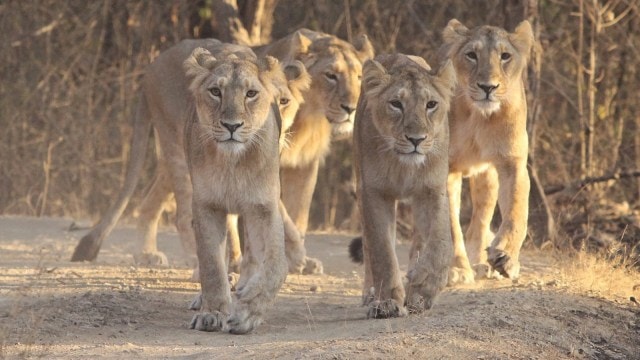Gujarat Hardlook | King’s Guards: Asiatic lions at risk as lion sighting alerts increase near train tracks
As more lions begin straying close to the busy railway track connecting the Pipavav port in Amreli, the casualties are only rising, increasing the need for surveillance. That’s where the lion trackers come in. GOPAL KATESHIYA spends a day with two such trackers.
 The Pipavav-Surendranagar track runs through Savarkundla and Rajula ranges where lions, the endangered species of big cats, have settled since early 2000. (Express File Photo)
The Pipavav-Surendranagar track runs through Savarkundla and Rajula ranges where lions, the endangered species of big cats, have settled since early 2000. (Express File Photo)The Pipavav-Surendranagar track connects the busy Pipavav Port on the coast in Amreli’s Rajula taluka with the rest of the country. Hence, a majority of the trains plying in this part of Amreli are goods trains — some of them double stack container trains. But the track runs through Savarkundla and Rajula ranges where Asiatic lions, the endangered species of big cats, have settled since early 2000. However, a spate of lion deaths after being run over by trains in the region have set alarm bells ringing. Seven lions were killed in six months — between July 21, 2023, and January 21, 2024 — after they were run over by trains on the Pipavav-Surendranagar section. The casualties assume significance as only nine lions died on the tracks in an entire decade (between April 2013 and March 2023), according to forest department data.
With rising casualties, there is an increasing need for surveillance. The trackers’ knowledge about lion behaviour and hard training is what keeps them going.
Once a gangman…
Bhavesh Parmar looks at the pattern in the fine dust bordering a cotton field abutting a forest watch tower and a railway track, somewhere between Khadkala and Borala in Amreli district, on a cold January morning. “Sir, do you see these pugmarks of cubs and lionesses? It is that pride with three cubs,” he tells his boss Yasin Juneja, 39, a forester who is on the rounds.
Juneja realises the pug marks are only a few hours old and asks Parmar to “remain alert” through the night. The latter nods.
Informing the railway tracker that the watchtower will get a coat of paint soon, Juneja speeds to Badhada village, some 25 kms south towards Pipavav port. A lion was run over by a locomotive engine in this village in 2017.
 Forester Yasin Juneja (left) and railway tracker Bhavesh Parmar look at pugmarks near the railway track in Khadkala village. (Express Photo by Gopal Kateshiya)
Forester Yasin Juneja (left) and railway tracker Bhavesh Parmar look at pugmarks near the railway track in Khadkala village. (Express Photo by Gopal Kateshiya)
Parmar, 25, has spent 18 months as a railway tracker keeping vigil on his allotted three-km-long stretch of the busy railway line every night. His job is to try and ensure that during dark hours, Asiatic lions, in their last abode in the world in Gir, are not run over by trains.
Parmar says there is always risk to his life while protecting the beast. He recalls an instance when a lion charged at him around eight months ago. “After receiving messages that a lion had preyed on a blue bull (nilgai) in Khadkala gauchar (community grazing land) near the track, I went to the spot at around 4 pm. However, the male lion became uncharacteristically aggressive, started growling and charged at me. I started backtracking and had my heart in my mouth. Luckily, I found a tree and then stood firm beside its trunk while swinging my stick and shouting aloud,” recalls the tracker, who has a one-and-a-half-year-old son.
Son of a railway officer, Parmar had dropped out of school after Class IX and was working as a contractual gangman with the railways before he was picked by the forest department for manning the track on its behalf. Forest staff gave him on-the-job training for three months before assigning him a 3-km railway line stretch from Borala crossing to Khari culvert.
“I start tracking movement of lion prides in my area from 4 pm so that I can have a fair idea of where they are at dusk. But as they are nocturnal animals, lions start moving from 6 pm onwards and my testing time starts,” he says.
 Lions on railway tracks near Uchaiya in Amreli on January 17. (Image source: Gujarat Forest Department)
Lions on railway tracks near Uchaiya in Amreli on January 17. (Image source: Gujarat Forest Department)
The tracker says he cannot follow a pride if it starts moving away from the track. “Doing so can expose some other animals to risks. At the same time, given the vegetation, it’s difficult to ascertain if the pride has taken a ‘U’ turn and is heading back to the track to sit on the warm ballast on the railway track during winters or to escape mosquitoes and other flies during monsoon when much of Shetrunji floodplains turns bogy,” Parmar explains.
From the track to the watchtower, a meal break, and then back to the railway track, Parmar goes home after 6 am. Parmar rests and sleeps during late mornings and afternoons. There are rare instances when his wife partakes in his job informing him about the presence of the beast. “While I would be patrolling some other part of the track, my wife would call me, informing me that lions are roaring near our house which is right beside the railway track in Khadkala village,” adds Parmar.
From farm to track
Meru Boricha, 35, who has been a railway tracker for five years is almost a veteran. It is 6 pm and Boricha, a resident of Luvara village, is already on the job to patrol the 4 kms of railway line from Badhada village to Ramgadh crossing.
Juneja takes an update from him on the work to erect a watchtower at Badhada.
Parmar and Boricha were among the seven railway trackers engaged by Rajula range. But after the latest spate of lion deaths began in July last year, Rajula range has added seven more trackers. There are 45 more such trackers in Rajula range.
Trackers have to be alert about animal carcasses also as they can attract lions. “Around a month ago, lions preyed on a goat near the track. We had to remove the carcass away from the track to prevent accidents involving lions,” says Boricha, who has a 12-year-old son. He recalls how his heart started racing when a male lion occupied the track and a train was about to pass through the same area around six months ago. “I immediately called the forest guard of my area and also alerted Dahya Khimsuriya, a fellow tracker from whose direction the train was to come. “Our officers promptly alerted railway officers and they halted the train. Eventually, we managed to shoo the lion away from the track.”
Rajdeepsinh Zala, deputy conservator of forests (DCF) of Gir (east) wildlife division, says that the trackers work in very challenging conditions. “But removal of vegetation from the track embankment will also help in avoiding our trackers moving too close to lions as they will have better visibility and lions won’t have bushes on the tracks to seek refuge,” says the DCF, adding, the department is providing trackers with torches, binoculars, green-coloured safety jackets, etc.
Boricha, who has studied till Class XII and was a farmer before he got recruited as a railway tracker, recalls a close encounter with another male lion. “A few months ago, agricultural labourers who were picking cotton in a field, alerted us about a lion there. So, I, along with three other staff members, started scanning the field and in the process I moved too close to the lion. The beast warned me. For a moment, I got scared. But then I stood my ground, as we have been trained to do,” says Boricha, adding, “Sometimes, when my son asks me, I recount stories of lions and the work I do.”
So far, the forest department has not seen any serious incidents involving trackers who are paid anywhere between Rs 13,000 to Rs 23,000 per month. “The thumb rule is to stand your guard when the lion becomes aggressive. If you run, it is more likely that the lion will catch up and injure you,” he says. He advises that one better stand, shout at the top of one’s voice, and beat the stick to the ground to ward off the beast
The Port Math
The busy Pipavav port is a private entity run by Gujarat Pipavav Port Limited (GPPL). When it was incorporated in 1992, the GPPL was originally a joint venture of the Gujarat government and private firm Sea King Infrastructure Limited. Later on, the state government divested its holding in GPPL, handing over control of the port to private entities. Currently, APM Terminals, the ports operations arm of The Hague-headquartered global logistics giant APM Mollar-Maersk has controlling stake in GPPL. The group signed an MoU with the Gujarat government at the 10th Vibrant Gujarat Summit in January this year for construction of a liquid berth, container berth and yard, container handling equipment, and marine infrastructure at Pipavav port at an estimated cost of Rs 3,320 crore.
GPPL is the private entity in the public private partnership (PPP), called Pipavav Railway Corporation Limited (PRCL), with the Indian Railways. PRCL owns the railway track from Pipavav port to Surendranagar via Amreli.
The traffic at this all-weather port has been increasing, data put in public domain by GPPL shows. The port handled 7.64 lakh containers (20-foot equivalent unit or TUEs), 3.91 million metric tonnes (mmt) of dry cargo, 1.03 mmt of liquid cargo and 40,000 cars in 2022-23. The port also handled 1,921 container trains, transporting a total 4.60 lakh containers (TUEs). In the first nine months of 2023-24, the port handled 5.64 lakh containers (TUEs) and transported 3.45 lakh of them by railroad by handling 1,738 trains. The figures of dry bulk cargo, liquid cargo and roll-on-roll-off units or cars stand at 3.22 mmt, 0.75 mmt and 25,000 respectively. Accordingly, the cargo handled by PRCL has zoomed from mere 0.39 mmt in 2003-04 to 6.93 mmt, including 0.45 mmt of non-port cargo, by 2021-22, PRCL data shows.
A busier port means more trains keep chugging on this railway line whose 90-km section from Pipavav to Lilia crosses through the lion territory. The containers look intimidating as they stream through this landscape that is a mosaic of agricultural fields dotted by scrublands, rivers and streams, hillocks, and herds of blue bulls (nilgais), wild boars, cows and buffaloes — all animals that lions prey on — grazing in pastoral lands or even raiding farmers’ standing crops even during daytime.







